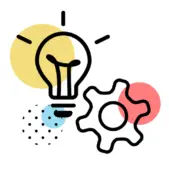No one day at a design agency is the same, especially here at UpTop. Every project is unique, and every client comes with their own set of requirements, timelines, and budgets. Practicing an ideal UX design process can be challenging when the only constant is change.
Despite these variables, UpTop remains committed to providing maximum value to our clients. Here’s a synopsis of the key steps in our current UX design process:

1. The Discovery Phase
To effectively assist our clients, we start with a comprehensive understanding of their business and customers. Our goal is to identify the core challenge at the intersection of business operations and customer needs.
Through interviews, workshops, analysis, and evaluation, we gain clarity on the problems we need to solve. We explore your business model, customer pain points, and technological constraints. By mapping your customer’s journey alongside your capabilities, we pinpoint precise issues and design tailored solutions that fit seamlessly into your existing framework.
2. Research
In this stage, we observe your customers interacting with your existing product or app. This enables us to understand their pain points firsthand and gather suggestions for improvements. We supplement these qualitative insights with quantitative analysis using behavior-tracking tools such as Hotjar, Amplitude, Clarity or Google Analytics.
By blending qualitative user research with quantitative data, we identify core issues that may even redefine our original problem statement from the Discovery phase.
3. Ideation, Prototyping, Testing, and Iteration
At the heart of our UX design process is a lean, iterative methodology. We prioritize quickly generating and validating ideas through rapid prototyping. Our design team utilizes a customer-centric design-thinking approach, swiftly moving from ideas to low-fidelity prototypes to validate concepts efficiently.
We employ collaborative techniques like structured brainstorming sessions, feature prioritization workshops, and effort-impact analysis. Modern collaborative design tools such as Figma enable us to build interactive prototypes rapidly, promoting real-time collaboration internally and externally.
We validate prototypes using iterative testing methods like R.I.T.E. (Rapid Iterative Testing and Evaluation). Rapid iteration based on direct user feedback ensures we consistently refine and enhance the design.
Throughout this process, we maintain close partnerships with our clients, involving them in key design decisions to ensure alignment and transparency. The goal is not merely to produce a product, but to craft a holistic, user-centered experience.
4. Wireframes and Visual Design
After concept validation, we move toward designing the complete user experience, defining key screens, interactions, and user flows. Currently, our teams rely primarily on Figma, an industry-standard tool that seamlessly integrates wireframing, prototyping, and visual design into a single collaborative platform.
Next, we apply high-fidelity visual designs onto wireframes, following your existing brand style guide or developing a custom design system. This step ensures a cohesive, polished user interface that aligns with your brand identity, ready to hand off to the development team for implementation.
Crafting Holistic Experiences: Our UX Design Commitment
Our UX design process is central to delivering successful digital experiences. We continuously balance thorough research, rapid iteration, and practical execution. At UpTop, our commitment remains clear: delivering tangible value for you and your customers. Let’s connect to discuss how we can help overcome barriers and enable successful digital transformation.


